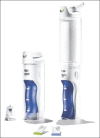Recent challenges in insulin delivery systems: a review
- PMID: 20046733
- PMCID: PMC2792528
- DOI: 10.4103/0250-474X.42968
Recent challenges in insulin delivery systems: a review
Abstract
Relatively, a large percentage of world population is affected by diabetes mellitus, out of which approximately 5-10% with type 1 diabetes while the remaining 90% with type 2. Insulin administration is essential for type 1 patients while it is required at later stage by the patients of type 2. Current insulin delivery systems are available as transdermal injections which may be considered as invasive. Several non-invasive approaches for insulin delivery are being pursued by pharmaceutical companies to reduce the pain, and hypoglycemic incidences associated with injections in order to improve patient compliance. While any new insulin delivery system requires health authorities' approval, to provide long term safety profile and insuring patients' acceptance. The inhalation delivery system Exubera((R)) has already become clinically available in the United States and Europe for patients with diabetes as non-invasive delivery system.
Keywords: Diabetes mellitus; Exubera®; insulin; non-invasive delivery systems.
Figures


References
-
- Rosenfeld L. Insulin: Discovery and controversy. Clin Chem. 2002;48:2270–88. - PubMed
-
- Verge D. Biotechnological and administration innovations in insulin therapy. Med Sci (Paris) 2004;20:986–98. - PubMed
-
- Walsh G. Therapeutic insulins and their large-scale manufacture. Appl Microbiol Biotechnol. 2005;67:151–9. - PubMed
-
- Saltiel AR, Khan CR. Insulin signaling and regulation of glucose and lipid metabolism. Nature. 2001;414:799–806. - PubMed
-
- Rotte M, Baerecke C, Pottag G, Klose S, Kanneberg E, Heinze HJ, et al. Insulin affects the neuronal response in the medial temporal lobe in humans. Neuroendocrinology. 2005;81:49–55. - PubMed
LinkOut - more resources
Full Text Sources
Other Literature Sources
